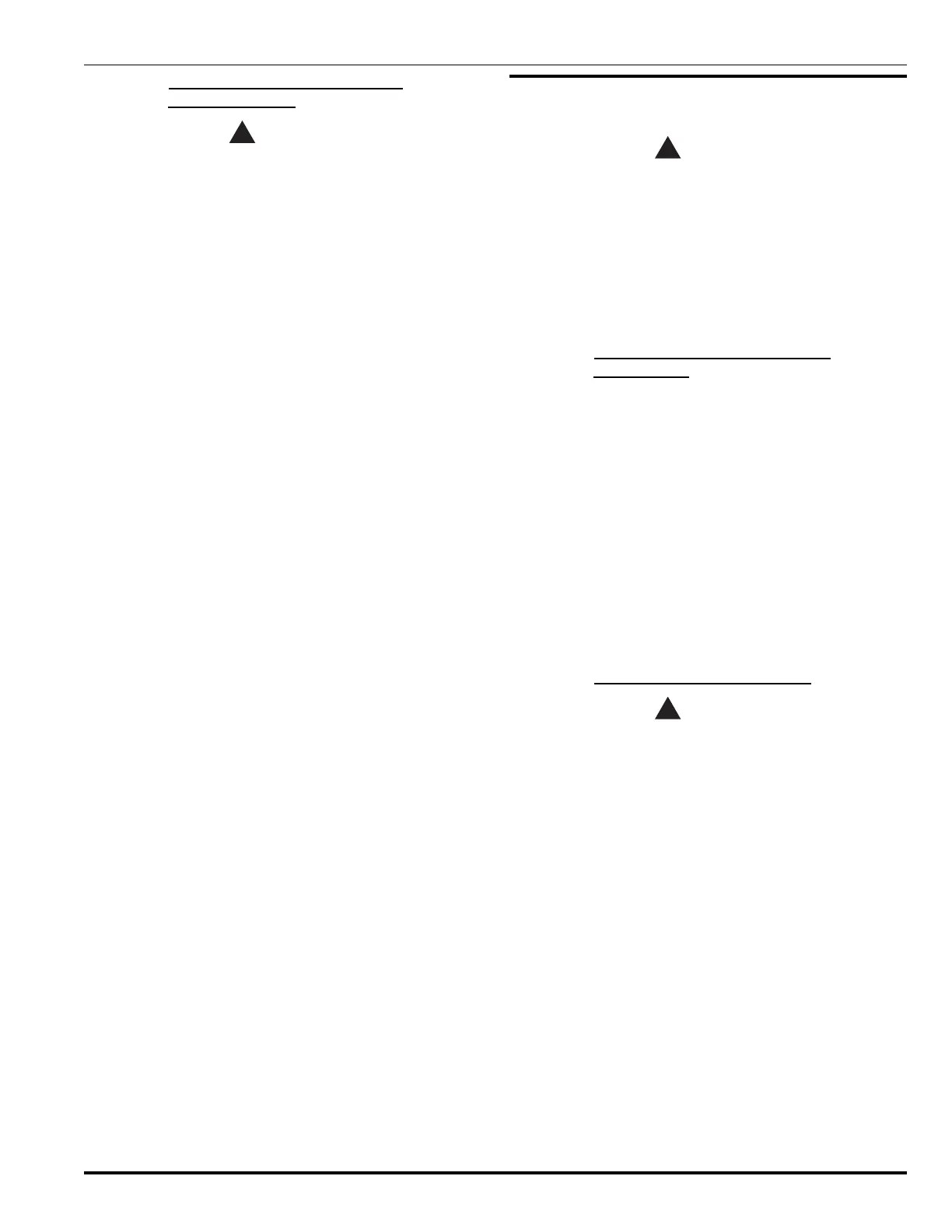6-9September 2004 90-FM200M-000
FM-200
®
ECS Series Engineered Fire Suppression Systems
6-3.4 Salvaging FM-200 from a Leaking
Cylinder Assembly
WARNING
!
Target container must be significantly larger
than the source container to prevent dangerous
pressure buildup.
1. Close the FM-200 supply valve (Item 19) and close
valve (Item 21). Open valve (Item 20) to vent pressure.
Disconnect the charging flexible hose from the FM-200
supply valve (Item 19).
2. Connect the salvage discharge assembly to the flex-
ible hose coupling. Then assemble the discharge as-
sembly to the outlet port of the leaking cylinder assembly
(not shown).
3. Position an empty cylinder assembly of suitable
size for FM-200 storage on the scale. Record the
empty weight.
4. Connect the recharge adapter (Item 1) to the empty
cylinder outlet port.
5. Assemble a manually operated control head onto
the cylinder valve actuation port of the leaking cylin-
der assembly.
6. Check that all charging system valves are closed. Open
valves (Items 8, 9, 10, 11, 21 and 27). Set the manually
operated control head to the OPEN position. The pres-
sure gauge (Item 28) should indicate the supply pres-
sure. Crack vent valve (Item 30) until FM-200 liquid is
present. Shut valve (Item 30).
7. If the cylinder assembly on the scale is of sufficient
size and is being used to store FM-200, monitor the
scale, open the valve (Item 29) and start the pump.
Continue pumping until a maximum of FM-200 is trans-
ferred from the leaking cylinder assembly as indicated
by a pressure drop on the pressure gauge.
8. If the cylinder assembly on the scale is being charged,
fill with the required weight of FM-200 by adding the
required pounds to the empty cylinder weight. Follow
the charging procedure outlined in steps 9 through 21
of Paragraph 6-3.2. Conduct a cylinder leak test as de-
scribed in Paragraph 6-3.3.
9. Continue to transfer the FM-200 agent until the leaking
cylinder assembly is empty as indicated by pressure
drop as measured by the pressure gauge. Shut off the
pump and close the hose control valve (Item 29) and
valve (Item 21).
10. Open valve (Item 20) to vent pressure, then disas-
semble the adapter from the outlet port of the leaking
cylinder assembly and from the flexible hose hookup.
Reassemble the flexible hose to the FM-200 supply
valve (Item 19).
11. If the cylinder assembly being recharged, is not charged
sufficiently, continue the charging procedure as indi-
cated in Paragraph 6-3.2 using the FM-200 supply.
6-4 NITROGEN PILOT CYLINDER SERVICE
AND MAINTENANCE
WARNING
!
Any area in which nitrogen is used or stored
must be properly ventilated. A person working
in an area where air has become enriched with
nitrogen can become unconscious without
sensing the lack of oxygen. Remove the victim
to fresh air. Administer artificial respiration if
necessary and summon a physician. Never
dispose of liquefied nitrogen in an indoor work
or storage area.
6-4.1
Nitrogen Pilot Cylinder Hydrostatic
Pressure Test
A hydrostatic test must be performed in accordance with
DOT regulations CFR Title 49, Section 173.34.
Nitrogen cylinders shall not be recharged and shipped with-
out hydrostatic test if more than five years has elapsed from
the date of the last test.
Nitrogen cylinders continuously in service without dis-
charging can be retained in service for a maximum of
five years from the date of the last hydrostatic test. At
the end of five years the cylinder shall be visually in-
spected per CGA pamphlet C-6.
Cylinders must also be hydrostatic pressure tested imme-
diately if the cylinder shows evidence of distortion, crack-
ing, corrosion or mechanical or fire damage.
6-4.2 Nitrogen Cylinder Replacement
WARNING
!
When removing a pressurized cylinder due
to pressure loss, the control head must be in
the SET position with the safety pull pin
installed. A control head in the released
position will cause the remaining contents of
cylinder to discharge resulting in a system
activation which may damage property and
cause bodily injury.
Replace the nitrogen cylinder when expended or when loss
of pressure occurs, as follows:
1. Remove the control head from the nitrogen
cylinder valve.
2. Immediately install the protection cap on the nitrogen
cylinder actuation port.
3. Remove the flexible actuation hose or tubing and adapter
(P/N 6992-0501) from the cylinder valve outlet.
4. Remove the clamps and hardware that secure the ni-
trogen cylinder to the mounting bracket.
